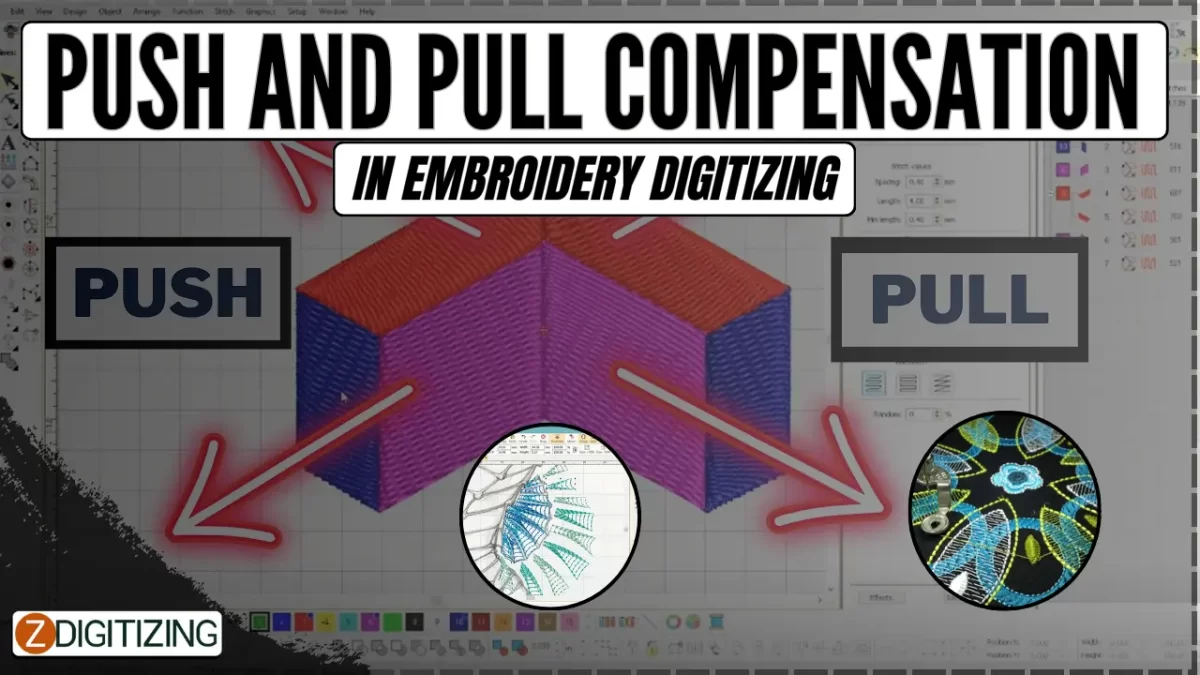Push And Pull Compensation In Embroidery Digitizing

Embroidery digitizing is a fascinating craft that requires precision, skill, and attention to detail. As embroidery machine owners, you may have encountered the terms “push” and “pull” compensation in your digitizing journey. But what do these terms mean, and how do they impact the quality of your embroidered designs? In this guide, we’ll explore the concept of push and pull compensation in embroidery digitizing, its importance in achieving flawless embroidery results, and how ZDigitizing, a leading digitizing company, can assist you in optimizing your designs. Plus, we’ll address some FAQs to provide clarity on this topic and help you enhance your digitizing skills.
Understanding Push and Pull Compensation in Embroidery Digitizing
Push and pull compensation are techniques used in embroidery digitizing to counteract the natural tendencies of fabrics to shift or distort during the stitching process. These phenomena occur due to factors such as fabric stretch, thread tension, and stitch density, which can cause the embroidery design to appear misaligned or distorted.
Push Compensation:
Push compensation involves adding extra stitches to the outer edges of a design to “push” the fabric outward during stitching. This helps to counteract the inward pulling effect that occurs when stitches are made in close proximity to each other. Push compensation is typically used in designs with dense stitching or intricate details where fabric distortion is more likely to occur.
Pull Compensation:
Pull compensation, on the other hand, involves reducing the number of stitches in certain areas of a design to “pull” the fabric inward during stitching. This helps to compensate for the outward pushing effect that occurs when stitches are spaced too far apart. Pull compensation is commonly used in designs with open spaces or areas of low stitch density to prevent gaps or puckering in the fabric.
Importance of Push and Pull Compensation in Embroidery Digitizing
Push and pull compensation are essential techniques in embroidery digitizing for several reasons:
- Maintaining Design Integrity: Push and pull compensation help to ensure that the embroidered design maintains its intended shape, alignment, and proportions during stitching. By compensating for fabric stretch and tension issues, these techniques prevent distortion and maintain the integrity of the design.
- Preventing Fabric Distortion: Push and pull compensation minimize the risk of fabric distortion, puckering, or misalignment that can occur during the stitching process. This results in smoother, more even embroidery with consistent stitch quality and appearance.
- Enhancing Durability: Proper push and pull compensation contribute to the longevity and durability of embroidered designs by reducing stress on the fabric and threads. By distributing tension more evenly across the design, these techniques help to prevent thread breakage, fraying, or seam puckering over time.
How ZDigitizing Can Assist You with Push and Pull Compensation
ZDigitizing is a trusted name in the embroidery digitizing industry, known for its expertise in providing high-quality digitizing services to embroidery enthusiasts and businesses. Here’s how ZDigitizing can assist you in optimizing your embroidery designs with push and pull compensation:
- Custom Digitizing Services: ZDigitizing offers custom digitizing services tailored to your specific requirements and preferences. Their experienced digitizers can analyze your designs and implement. Push and pull compensation techniques to ensure optimal stitch quality and fabric stability.
- Expert Guidance and Support: The team at zdigitizing is dedicated to providing expert guidance and support to help you achieve your embroidery goals. Whether you have questions about push and pull compensation. Design optimization, or machine compatibility, they are there to assist you every step of the way.
- Quality Assurance: ZDigitizing maintains stringent quality assurance standards to ensure. All digitized designs meet the highest standards of accuracy and precision. Their rigorous quality control process includes thorough testing. Inspection to identify and rectify any issues related to push and pull compensation.
Conclusion
Push and pull compensation are indispensable techniques in embroidery digitizing. Ensuring that embroidered designs maintain their integrity and quality during stitching. By understanding the principles of push and pull compensation and leveraging. The expertise of companies like ZDigitizing, you can achieve flawless embroidery results with confidence.
FAQs
Q: How do I know if push or pull compensation is needed in my embroidery design?
A: Push and pull compensation may be needed in your embroidery design. If you observe issues such as fabric distortion, puckering, or misalignment during stitching. Consult with a digitizing expert like ZDigitizing for guidance on implementing push and pull compensation techniques.
Q: Can push and pull compensation be adjusted for different types of fabrics?
A: Yes, push and pull compensation can be adjusted based on the type of fabric you’re embroidering on. Fabrics with different stretch, thickness, or texture may require varying levels of push and pull compensation to achieve optimal results.
Q: Can ZDigitizing help me troubleshoot push and pull compensation issues in my embroidery designs?
A: Yes, ZDigitizing offers expert advice and support to help you troubleshoot push and pull compensation issues in your embroidery designs. Their experienced team can analyze your designs and recommend adjustments to optimize stitch quality and fabric stability.









